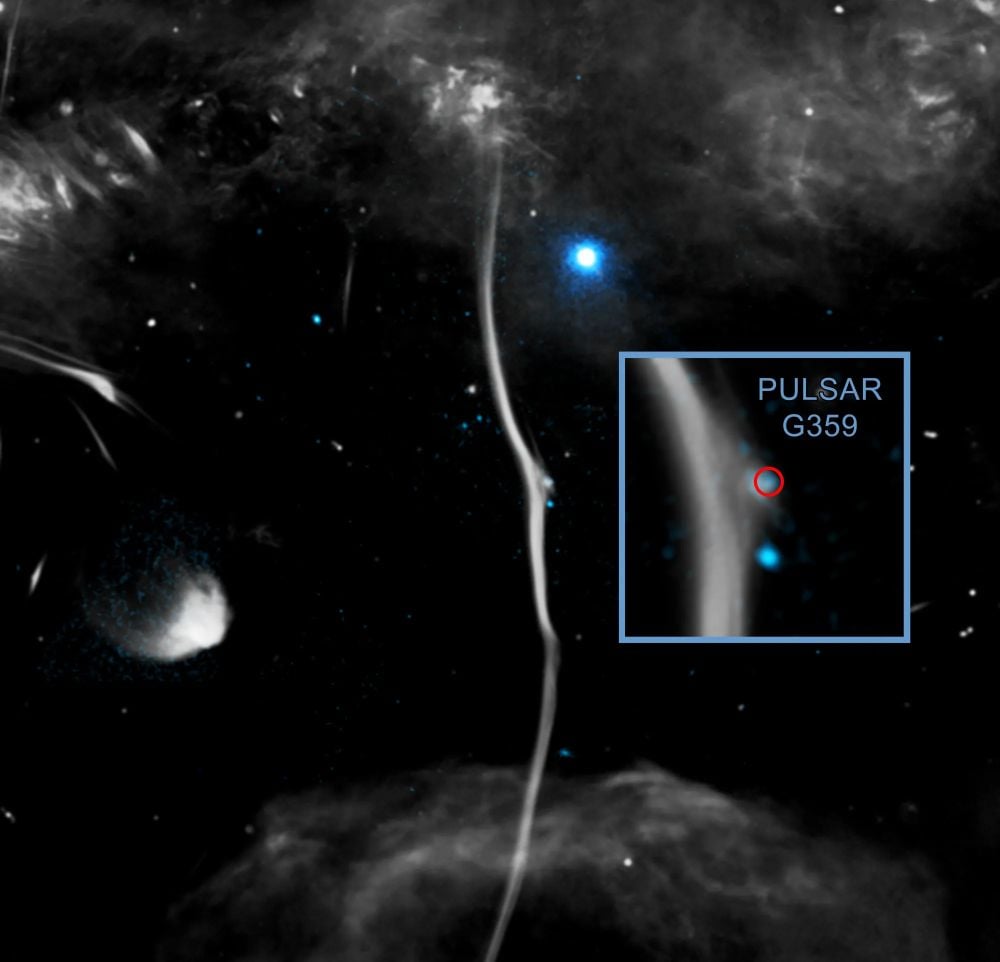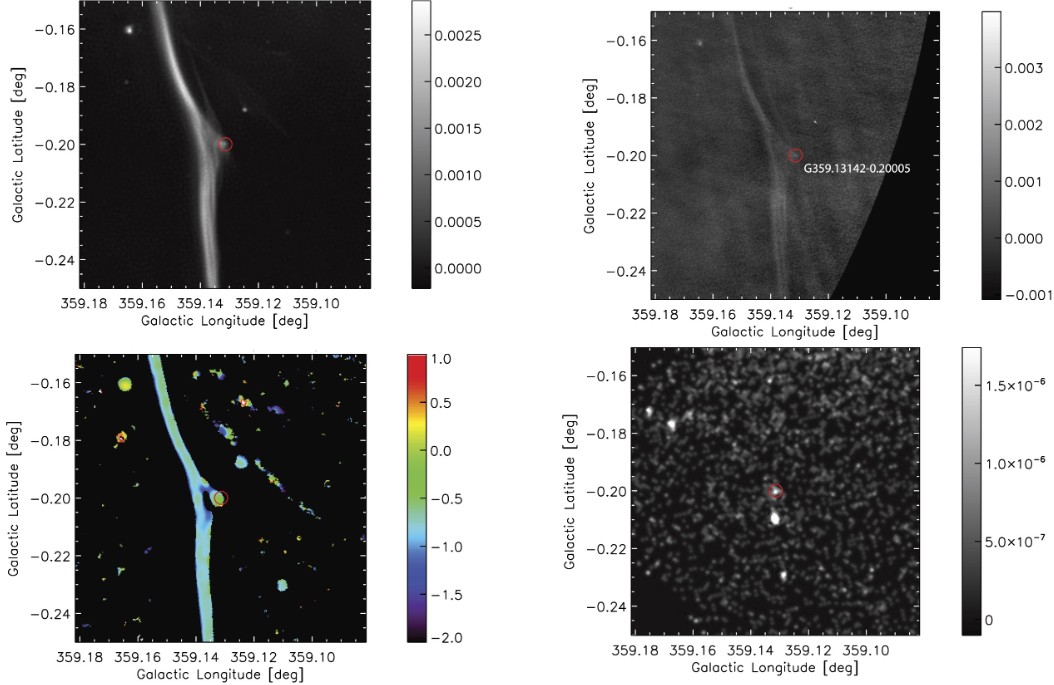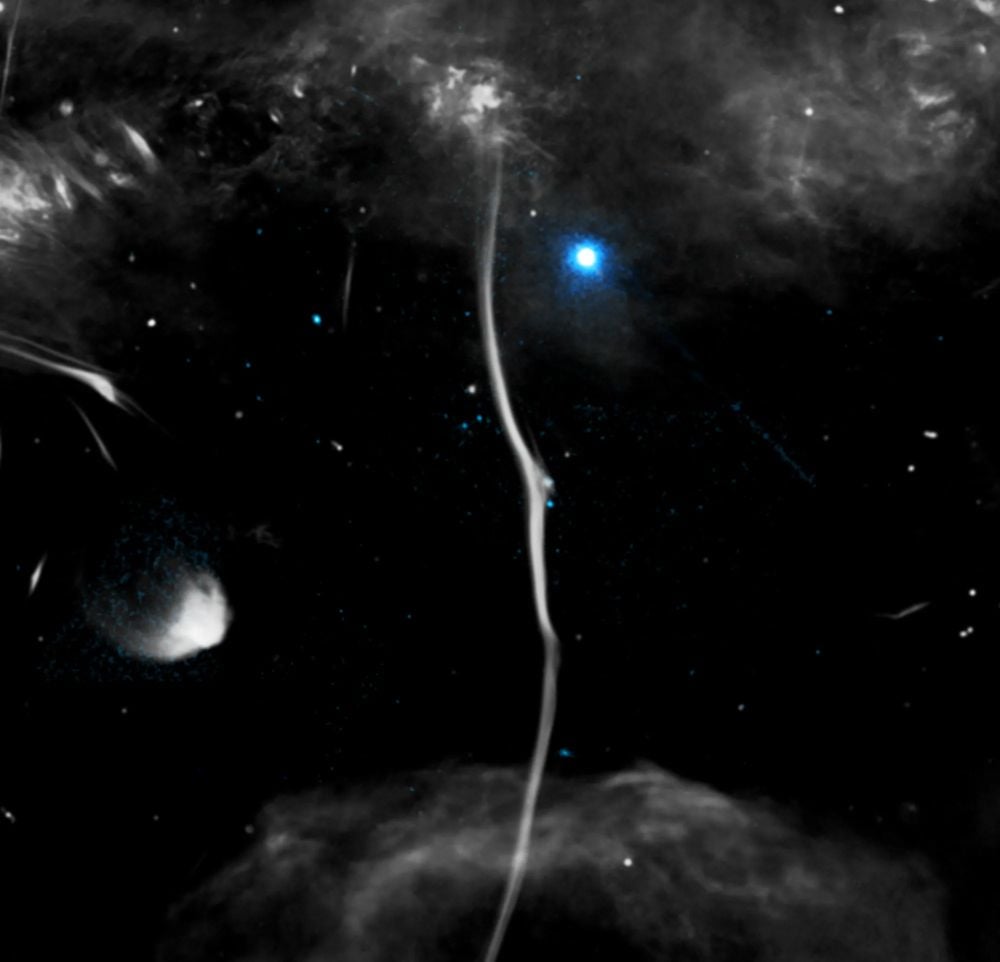The center of the Milky Way is a busy place, tightly packed with stars and dominated by the supermassive black hole Sagittarius A*. It also features powerful magnetic fields that regulate star production, influence gas dynamics and gas cloud formation, and even affect the accretion processes around Sagittarius A*. Gigantic filaments of gas that look like bones form along the magnetic field lines, and one of them appears to be fractured.
The filaments consist of accelerated particles spiralling along the magnetic lines. The energized particles release radio waves that are detectable by radio telescopes like the MeerKAT array in South Africa. MeerKAT observations and observations from NASA's Chandra X-ray telescope have given scientists a deeper look at these filaments.
One of the filaments is named the Snake due to its appearance. The Snake is one of the region's longest and brightest filaments, extending for 230 light-years. It has an unusual morphology, which scientists describe as kinked or fractured.
New research in the Monthly Notices of the Royal Astronomical Society examined the Snake and determined that a rapidly moving pulsar has created the kink. The researchers used Chandra, the VLA, and MeerKAT to identify an X-ray and radio source near the kink, named G359.13142-0.20005 (G359.13 for short).
The Snake is a remarkable Galactic Centre radio filament with a morphology characterized by two kinks along its ~20 arcmin extent," the authors write in their paper. "The major and minor kinks are located where the filament is most distorted from a linear magnetized structure running perpendicular to the Galactic plane.
 *This image combines MeerKAT data (grey) with Chandra data (blue) to show the presence of a pulsar near the kink in the filament called the Snake. Image Credit: X-ray: NASA/CXC/Northwestern Univ./F. Yusef-Zadeh et al; Radio: NRF/SARAO/MeerKat; Image Processing: NASA/CXC/SAO/N. Wolk*
*This image combines MeerKAT data (grey) with Chandra data (blue) to show the presence of a pulsar near the kink in the filament called the Snake. Image Credit: X-ray: NASA/CXC/Northwestern Univ./F. Yusef-Zadeh et al; Radio: NRF/SARAO/MeerKat; Image Processing: NASA/CXC/SAO/N. Wolk*
A pulsar is a rapidly spinning neutron star. Neutron stars form when a massive star collapses and explodes as a supernova. These extraordinarily dense stellar objects often experience a kick from the explosion, sending them away at high speeds. G359.13 seems to be travelling at a high speed, causing the kink.
We present Chandra, VLA, and MeerKAT data and report the detection of an X-ray and radio source at the location of the major kink," they continue. "The radio luminosity and steep spectrum of the compact source are consistent with a pulsar.
 This figure from the research shows different observations of the Snake and the pulsar. The upper left image is from MeerKAT. The upper right is from the Very Large Array. The lower left is similar to the upper left but with a spectral index distribution. The lower right is an X-ray image from Chandra. Image Credit: Yusef-Zadeh et al. 2025 MNRAS.
This figure from the research shows different observations of the Snake and the pulsar. The upper left image is from MeerKAT. The upper right is from the Very Large Array. The lower left is similar to the upper left but with a spectral index distribution. The lower right is an X-ray image from Chandra. Image Credit: Yusef-Zadeh et al. 2025 MNRAS.
Pulsars have high radio luminosity because of their coherent emission. In coherent emission, charged particles are radiated synchronously, making their radio emissions more concentrated and luminous. Astrophysicists aren't sure what causes their coherent emission, but it's likely related to pulsars' extreme magnetic fields and plasma environments.
The researchers say that G359.13's velocity is between one million and two million miles per hour. When it struck the filament, it distorted the magnetic field, kinking the Snake.
According to the researchers, the pulsar created both kinks in the snake. The large kink was created by the pulsar injecting relativistic particles and distorting the magnetic fields, and the pulsar itself created the secondary kink.
"We argue that the major kink is created by a fast-moving (~500–1000 km s^−1^) object punching into the Snake, distorting its magnetic structure, and producing X-ray emission," the authors write. "X-ray emission pinpoints an active acceleration site where the interaction is taking place. A secondary kink is argued to be induced by the impact of the high-velocity object producing the major kink."
The attempt to understand this radio filament and its fractures or kinks is an ongoing process. This paper is just the latest attempt to study and explain it; it won't be the last.
Future sensitive and high-resolution imaging at radio and X-rays, including proper motion measurements, will examine the interaction picture that we described here," the researchers conclude. "These measurements provide insights on the origin of one of the most remarkable radio filaments in the Galactic Centre.
More:
 Universe Today
Universe Today
